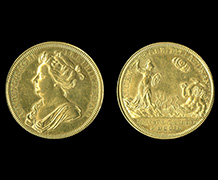
Queen Anne medal credit: Trustees of the British Museum
New discovery: Queen Anne's coronation medal was designed by Isaac Newton
To mark Queen Anne’s coronation, a ‘highly political medal’ was issued, initially thought to be designed by Sir Godfrey Kneller turns out to be the work of Isaac Newton, who was Master of the Mint when Anne was crowned in 1702.
A manuscript in the National Archives in Kew with sketches and notes by Newton was discovered by a researcher working on the Stuart Successions Project run by the Universities of Exeter and Oxford.
James Hone, a PhD student at Oxford said:“This find provides an insight into an often forgotten period of Newton’s career at the Royal Mint. It has long been understood that Newton used his scientific and mathematical expertise to establish a gold standard currency. But designing medals was usually the job of lesser Mint employees. Thanks to these documents we now know that Newton designed medals himself. Moreover, he used his extensive knowledge of mythology and symbolism in his medals.”
The notes shed light on the political message behind the medal, which was a small metallic token distributed for free to attendees and crowds at coronation ceremonies. The medal’s design shows Queen Anne as the goddess Athena striking down a double-headed monster. Hone explained:“Earlier scholars assumed this represented domestic faction/division, but Newton explains in his notes that he was referring to the double Catholic threat posed by Louis XIV of France and James Francis Edward Stuart, the Old Pretender with a rival claim to the throne.”
Professor Andrew McRae, of the University of Exeter and a co-director on the project said:“The Stuart Successions Project has enabled us to rethink the politics of monarch across the Stuart era (1603 to 1714). Queen Anne, like her Stuart predecessors, was deeply immersed in the complex and dangerous debates and conflicts of this period. As we start to think about the politics of a third King Charles, the Stuart Successions Project is helping us to understand the history of the monarchy and its place in the British nation.”
The Stuart Successions Project is a three-year project run by academics at the Universities of Exeter and Oxford. It is funded by the Arts and Humanities Research Council (AHRC) to examine the writing printed at moments of royal and protectoral succession in Britain between 1603 and 1702.
The discovery may also illuminate why Newton was knighted three years later in 1705. Historians have previously put this down to party politics, and Newton’s campaign to become MP for Cambridge, according to Hone, who is keen to point out that Isaac Newton’s role in designing medals for Queen Anne might have played a part too.
Date: 20 March 2015
